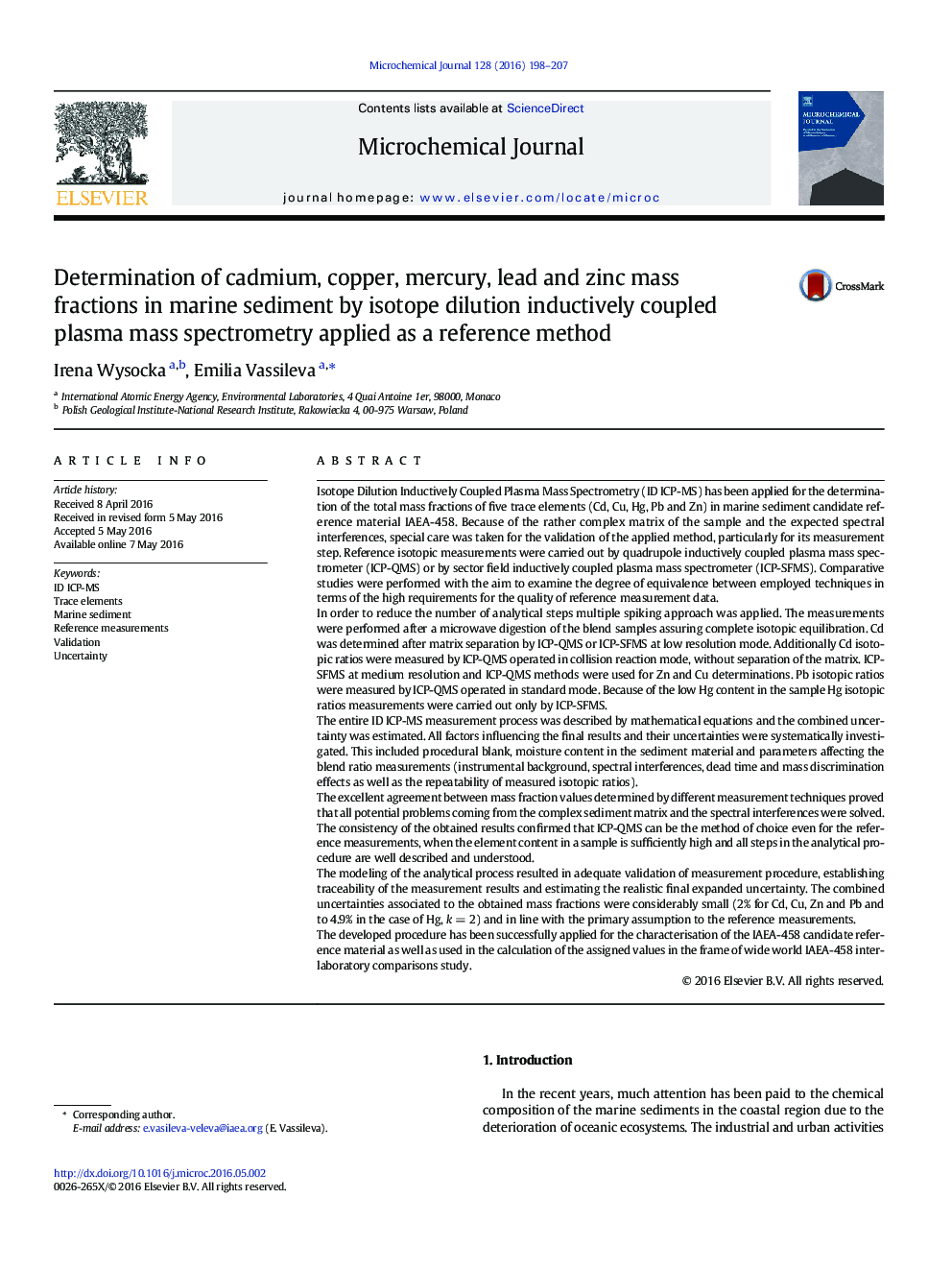| Article ID | Journal | Published Year | Pages | File Type |
|---|---|---|---|---|
| 1227558 | Microchemical Journal | 2016 | 10 Pages |
•Analytical procedure for reference measurements of Cd, Cu, Hg, Pb and Zn mass fractions in marine sediment is developed.•Isotope Dilution Inductively Coupled Plasma Mass Spectrometry (ID-ICP-MS) was applied as a primary method of measurements.•The ISO-17025 requirements were followed in the validation of the proposed analytical procedure.•The uncertainties on final results were from 1.5 to 4.6% (k = 2).•Obtained results were used as IAEA contribution in the certification process of the IAEA-458 marine sediment CRM.
Isotope Dilution Inductively Coupled Plasma Mass Spectrometry (ID ICP-MS) has been applied for the determination of the total mass fractions of five trace elements (Cd, Cu, Hg, Pb and Zn) in marine sediment candidate reference material IAEA-458. Because of the rather complex matrix of the sample and the expected spectral interferences, special care was taken for the validation of the applied method, particularly for its measurement step. Reference isotopic measurements were carried out by quadrupole inductively coupled plasma mass spectrometer (ICP-QMS) or by sector field inductively coupled plasma mass spectrometer (ICP-SFMS). Comparative studies were performed with the aim to examine the degree of equivalence between employed techniques in terms of the high requirements for the quality of reference measurement data.In order to reduce the number of analytical steps multiple spiking approach was applied. The measurements were performed after a microwave digestion of the blend samples assuring complete isotopic equilibration. Cd was determined after matrix separation by ICP-QMS or ICP-SFMS at low resolution mode. Additionally Cd isotopic ratios were measured by ICP-QMS operated in collision reaction mode, without separation of the matrix. ICP-SFMS at medium resolution and ICP-QMS methods were used for Zn and Cu determinations. Pb isotopic ratios were measured by ICP-QMS operated in standard mode. Because of the low Hg content in the sample Hg isotopic ratios measurements were carried out only by ICP-SFMS.The entire ID ICP-MS measurement process was described by mathematical equations and the combined uncertainty was estimated. All factors influencing the final results and their uncertainties were systematically investigated. This included procedural blank, moisture content in the sediment material and parameters affecting the blend ratio measurements (instrumental background, spectral interferences, dead time and mass discrimination effects as well as the repeatability of measured isotopic ratios).The excellent agreement between mass fraction values determined by different measurement techniques proved that all potential problems coming from the complex sediment matrix and the spectral interferences were solved. The consistency of the obtained results confirmed that ICP-QMS can be the method of choice even for the reference measurements, when the element content in a sample is sufficiently high and all steps in the analytical procedure are well described and understood.The modeling of the analytical process resulted in adequate validation of measurement procedure, establishing traceability of the measurement results and estimating the realistic final expanded uncertainty. The combined uncertainties associated to the obtained mass fractions were considerably small (2% for Cd, Cu, Zn and Pb and to 4.9% in the case of Hg, k = 2) and in line with the primary assumption to the reference measurements.The developed procedure has been successfully applied for the characterisation of the IAEA-458 candidate reference material as well as used in the calculation of the assigned values in the frame of wide world IAEA-458 inter-laboratory comparisons study.
